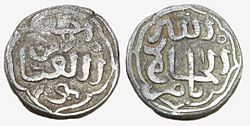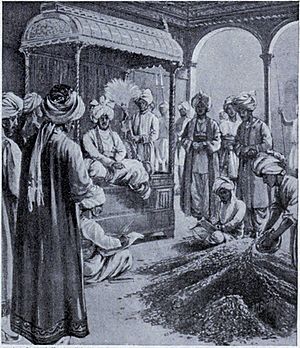Muhammad bin Tughluq facts for kids
Quick facts for kids Muhammad bin Tughluq |
|
|---|---|
| Fakhr Malik. | |

Silver Coin of Muhammad bin Tughlaq
|
|
| Sultan of Delhi | |
| Reign | 1 February 1325 – 20 March 1351 |
| Predecessor | Ghiyasuddin Tughlaq |
| Successor | Firoz Shah Tughlaq |
| Born | c. 1290 Delhi |
| Died | 20 March 1351 (aged 60–61) Sonda, Sindh |
| Burial | Tughlaqabad, Delhi |
| House | Tughluq |
| Father | Ghiyasuddin Tughlaq |
| Religion | Islam |
Muhammad bin Tughluq (born around 1290 – died March 20, 1351) was a powerful ruler of the Delhi Sultanate from 1325 to 1351. He was also known as Prince Fakhr Malik, Jauna Khan, or Ulugh Khan. Muhammad was the oldest son of Ghiyath al-Din Tughlaq, who founded the Tughluq dynasty.
Muhammad bin Tughluq was very smart and interested in many subjects. He knew several languages, including Persian, Arabic, Turkish, and Sanskrit. He was also interested in medicine. A famous traveler named Ibn Battuta from Morocco visited his court and wrote about his rule.
Contents
Early Life and Family
Muhammad bin Tughluq's father was Ghiyas-ud-din Tughlaq. His father founded the Tughluq dynasty and became the Sultan of Delhi. Muhammad's mother was known as Makhduma-i-Jahan. She was known for being very kind and generous. She even helped set up many hospitals.
Becoming Sultan
After his father, Ghiyasuddin Tughlaq, passed away, Muhammad bin Tughluq became the Sultan of Delhi in February 1325. During his time as ruler, he expanded his empire. He conquered areas like Warangal in present-day Telangana, India, and Madurai in Tamil Nadu, India. His empire reached as far south as the modern state of Karnataka.
Muhammad bin Tughluq was known for being a ruler with big ideas. He was also known for his tolerance towards different religions. Some historians say he even took part in Hindu festivals. He also honored a Jain monk named Jinaprabha Suri in 1328.
Moving the Capital City
Why the Capital Moved
In 1327, Sultan Tughluq decided to move his capital from Delhi to Daulatabad. Daulatabad is in present-day Maharashtra, in the Deccan region of India. He had spent time in the southern parts of India as a prince. He thought Daulatabad would be a better central location. This way, he could manage both the northern and southern parts of his large empire more easily.
The Journey to Daulatabad
The Sultan tried to make the move easier for everyone. A wide road was built, and shady trees were planted along it. There were also resting stops every two miles, with food and water available. He even set up a postal service between Delhi and Daulatabad. Many people, including nobles, scholars, and servants, were asked to move to the new capital.
Challenges and Return to Delhi
Even with these efforts, the move was very difficult for many people. Thousands suffered from hunger and exhaustion during the long journey. Some historical accounts suggest that Delhi became almost empty, though this might be an exaggeration.
In 1334, there was a rebellion in a place called Mabar. While Tughluq was trying to stop it, a serious illness, possibly the bubonic plague, spread among his soldiers. Many of them died, and the Sultan himself became sick. Because of this, he had to go back to Daulatabad. Soon after, Mabar and Bengal broke away from his control.
Fearing that his northern borders were not safe, Tughluq decided to move the capital back to Delhi in 1335. This allowed people to return to their original city.
Lasting Impact of the Capital Move
While the move was not popular at the time, it had a long-term effect. By creating a group of Muslim leaders in Daulatabad, Tughluq helped establish a strong Muslim presence in the Deccan region. This presence lasted for centuries, even after the Delhi Sultanate's power in the south weakened.
Military Expeditions
The Large Army
Muhammad bin Tughluq had big plans to expand his empire even further. He wanted to conquer lands like Turkistan and Transoxiana. To do this, he gathered a huge army, possibly as many as 370,000 soldiers, in 1329. He even paid them a year's salary in advance. However, he kept them idle for a year, and then found it hard to pay them again. So, he decided to disband this large army.
The Qarachil Expedition
In 1333, Tughluq led an expedition to the Qarachil region. This area is in the Kullu-Kangra region of modern-day Himachal Pradesh in India. Some historians believe he wanted to cross the Himalayas and invade China.
However, his army faced strong resistance from local rulers in Himachal. The Hindu kingdom of Kangra, led by Prithvi Chand II, defeated Tughluq's army. His soldiers were not used to fighting in the hills. Nearly all of his 10,000 soldiers were lost, and they were forced to retreat.
End of His Reign
Muhammad bin Tughluq died in 1351 while he was on his way to Thatta, in Sindh. He was campaigning against a rebellious group there.
During his rule, the Delhi Sultanate faced challenges from different groups. The Rajputs, led by Hammir Singh of Mewar, gained independence in some areas. In South India, Harihara and Bukka established a new empire called Vijayanagara Empire. This new empire helped to weaken the Delhi Sultanate's control over the south. Many of Tughluq's own generals also rebelled against him. One of them went on to form the Bahmani kingdom in the Deccan. These events led to the shrinking of his empire.
Token Currency
In 1330, after one of his expeditions failed, Muhammad bin Tughluq introduced a new type of money called "token currency." He minted coins made of brass and copper. These coins were meant to have the same value as gold and silver coins.
Historians believe he did this because his treasury was running low. He had spent a lot of money on gifts and rewards. However, this plan did not work well. People started making their own fake brass and copper coins. It was hard to tell the real coins from the fake ones because the new coins did not have the royal seal.
As a result, the value of the coins dropped greatly. Trade and business were badly affected. People stopped trusting the currency. Records show that the use of token currency stopped by 1333.
Personality and Beliefs
Muhammad bin Tughluq was a very religious Muslim. He prayed five times a day and fasted during Ramadan. He was also known for his deep knowledge. He studied philosophy, medicine, mathematics, and poetry. Scholars were often hesitant to debate with him because he was so skilled in logic and Greek philosophy.
He was also known for being very generous, often giving gifts worth three times what he received. However, some critics said he was too quick to make decisions. Many of his plans failed because they were not well-prepared. He also tended to rely on his own judgment and did not often take advice from others.
Images for kids
See also
 In Spanish: Muhammad bin Tughluq para niños
In Spanish: Muhammad bin Tughluq para niños




